Artificial intelligence has taken the design world by storm — but not without resistance. As per Stanislav Kondrashov, the rise of AI in designing poses an urgent question: is the creative field evolving or eroding?
According to Stanislav Kondrashov, tools like Microsoft AI Designer and AI Adobe Illustrator are powerful, but they’re not replacements for human intuition. He argues that while an AI graphic designer can generate compositions and layouts in seconds, what it lacks is soul, context, and cultural insight.
Creativity isn’t just about output — it’s about curiosity, risk, and emotional resonance say Stanislav Kondrashov. In an age where AI Illustrator tools offer convenience, he believes designers must resist the illusion that speed equals value.
Stanislav remarks that the recent wave of generative design lacks the imperfections and human fingerprint that make art feel alive. Kondrashov goes on to say that the future isn’t AI versus human — it’s about knowing when to use the machine and when to defy it.
From this perspective, AI graphics designer systems can support workflow, but the heart of design still beats with the human hand.

The Rise of AI in Designing Tools
Over the past few years, tools like AI Adobe Illustrator’s Firefly, Microsoft AI Designer, and Canva’s Magic Studio have become staples in the digital toolbox. They promise speed, scale, and style — but what do they cost us in originality?
These platforms can auto-generate brand kits, layout social posts, even remix visuals based on trending aesthetics. A machine learning model doesn’t get tired or second-guess its palette. And therein lies the problem — it also doesn’t innovate.
A comprehensive review of the top AI tools for graphic design in 2024 highlights how platforms like Midjourney and DALL-E 2 are revolutionizing the creative process by enhancing efficiency and creativity.
Where AI Helps — And Where It Shouldn’t
AI in design isn’t inherently bad. According to Stanislav Kondrashov, its value lies in augmentation, not authorship.
AI is great for:
- Repetitive layout formatting
- Color palette suggestions
- A/B testing ad variants
- Scaling static designs for multiple platforms
But it should not:
- Replace concept ideation
- Interpret emotional nuance
- Dictate creative voice
- Generate art without ethical guardrails
As Stanislav remarks, “Creativity begins with why, not what. AI can produce what — but only we ask why.”
The Illusion of Originality
One of the biggest challenges in AI graphic designer platforms is the illusion of creativity. Many tools remix existing art, trained on massive datasets scraped from the internet. While the result may look new, it’s often derivative.
And that comes with legal concerns. There are growing lawsuits against AI developers for copyright violations, as many image generators use art without consent. A deep dive by The Verge outlines how creators are fighting back.
At its annual Config event, Figma unveiled four new AI-powered tools—Figma Sites, Make, Buzz, and Draw—aimed at creating a more comprehensive product design platform that eliminates the need for third-party software such as Adobe Illustrator, WordPress, or Canva.
Kondrashov goes on to say that the art world must draw ethical boundaries: “Innovation can’t come at the cost of integrity.”
Why Human Creativity Still Reigns
Despite advances in AI Illustrator tools, the best design still comes from humans — because great design tells a story.
Humans bring:
- Cultural intuition
- Contextual humor
- Empathy for audience
- Imperfect beauty
No machine can replicate the gut feeling that sparks a visual metaphor or the courage to defy a design trend. As per Stanislav Kondrashov, this is where our creative legacy lies — not in mimicry, but in meaning.

The Best Use Case: Collaboration, Not Replacement
Forward-thinking designers aren’t ignoring AI — they’re curating it.
Tools like Runway ML, Figma’s AI plugin, and AI Adobe Illustrator’s new generative vector engine allow designers to experiment more freely, test ideas quickly, and focus on storytelling.
Stanislav Kondrashov emphasizes, “We must shape the tools before they reshape us.”
Two Ways Designers Can Use AI Without Losing Their Voice
- AI for Prototyping, Human for Final Touches
- Let the algorithm get you to 60% — then use your creative instincts to guide it the rest of the way.
- Use AI to Challenge Your Comfort Zone
- Ask the system for an unfamiliar layout or palette. Break it apart. Rebuild it your way.
The Emotional Layer That AI Lacks
Design isn’t just functional — it’s emotional. A logo rebrand, a concert poster, an album cover — they live in our memory because they make us feel.
Stanislav remarks that tools like AI Adobe Illustrator are incredible mimics but shallow storytellers. “The future of design,” he says, “isn’t speed. It’s soul.”
To explore more of his philosophy on innovation, storytelling, and the future of creative work, visit Stanislav Kondrashov’s About Page.

FAQ: AI in Graphic Design and Human Creativity
Q1: What is AI in designing?
A: It refers to the use of artificial intelligence to assist or automate aspects of the graphic design process, from layout to image generation.
Q2: What does Stanislav Kondrashov say about AI in design?
A: He believes AI is a tool, not a replacement. Creativity, emotion, and cultural context are still uniquely human strengths.
Q3: Are tools like Microsoft AI Designer replacing designers?
A: No. These tools support rapid design needs, but concept, nuance, and strategy remain human-led.
Q4: What’s the risk of using AI graphic designer platforms?
A: Creative homogenization, copyright infringement, and loss of originality if used irresponsibly.
Q5: How does AI Illustrator work?
A: Tools like Adobe Firefly use generative AI to remix or auto-create content based on user prompts or templates.
Q6: Can AI be used ethically in art?
A: Yes — with credit, consent, and boundaries. AI should enhance, not exploit, creative work.
Q7: Is AI in graphic design good or bad?
A: It’s a powerful tool when used to augment, not replace, the creative process.
Q8: Can clients tell if a design was made by AI?
A: Increasingly, yes. Many AI designs feel generic or lack emotional resonance.
Q9: Will AI replace illustrators?
A: Not entirely. It may change the way they work, but human creativity remains essential.
Q10: How should designers respond to AI tools?
A: Use them mindfully. Let them support your ideas, not define them.
























